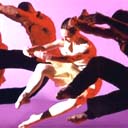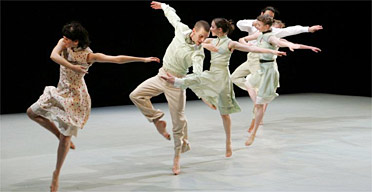In short
Initially a drop-out, then a rebel, Richard Alston has become part of the modern dance establishment. He was only ever interested in doing his own thing: developing a dance language and conversing with music.
Backstory
Born in 1948, Richard Alston was educated at Eton, but – true to the spirit of the 60s – dropped out at 16 to go to art college. A year later, inspired by a Royal Ballet performance (Frederick Ashton's La Fille Mal Gardée), he decided that he would become a choreographer. Fortuitously, the Contemporary Dance Trust – forerunner of London Contemporary Dance Theatre (LCDT) and School – was founded at almost exactly the same time, and Alston began classes there.
He began choreographing straight away. His formalist focus, which gained impetus after he and fellow student Siobhan Davies went to see the Merce Cunningham company in France, was very different to the theatrical style that LCDT was developing. Though he made his first piece for them at just 21, Alston again turned away from the mainstream to set up the country's first alternative contemporary dance group, Strider. A loose collective influenced by America's Judson Dance Theatre, Strider experimented with everyday movement, multimedia, task- or process-based compositional methods, and performed in non-theatre spaces such as galleries, halls and the outdoors. It survived only three years, but was a formative influence in establishing an independent modern dance sector.
In 1975, Alston went to New York to study at the Cunningham Studio; after returning in 1977, he set up Richard Alston and Dancers and also began choreographing for Ballet Rambert, where he became resident choreographer in 1980. Two years later he, Siobhan Davies and Ian Spink co-founded the influential group Second Stride, though Alston left a year later. In 1986, he joined the establishment, becoming artistic director of Ballet Rambert (changing its name to Rambert Dance Company) and developing a distinctive house style – painterly set designs, contemporary music, fleet and formal dancing. But in 1992, alarmed by falling revenues, the company board abruptly dismissed him. "I had just returned from holiday, and they told me not to come back in the morning,'' he later said.
In retrospect, it was a blessing in (heavy) disguise. At about the same time, London Contemporary Dance Theatre was losing its funding, and instead of disbanding it altogether, they formed a new, smaller company in 1994, the Richard Alston Dance Company. It's been the focus of Alston's creative output ever since, and it continues as one of the principal companies in the mainstream of British modern dance – while Alston himself continues to look like an art student from the 60s.
Watching Richard Alston
Alston's choreography always engages closely with its music, which ranges from pre-classical to postmodern, as well as jazz, folk and doo-wop. In rhythm, line, shape or phrasing, the dancing is always a response to the score. You can often glimpse fragments of stories or scenes – encounters, avoidances, departures – or feel different moods. But don't expect the dance to set out its meanings: those are up to you.
Do, though, take pleasure in the movement. Alston has a distinctive style, and his dancers are top-notch exponents of it. Partly his choreography looks like Merce Cunningham, with lots of curves and tilts in the body, and detailed steps; it's also balletic in its combination of fleet footwork, harmonious lines and proportioned phrases. But Alston uses more weight, breath and flow than either, resulting in a lilting, fluid quality enlivened by clear shapes and rhythms.
His love of music is evident; less well-known is his interest in new architecture. In fact, it's possible to see his work in architectural terms, with its space and light, paths and portals, flows of people. Alston is often thought of as an "English" choreographer. For some that is negative (too polite, reserved), for others it's positive (lyrical, well-crafted, not grandiloquent).
Who's who
During the Rambert years, Alston's regular lighting designer was Peter Mumford; with his current company it is Charles Balfour. When Alston uses piano music, Jason Ridgway is his pianist of choice. And Alston has worked with some outstanding dancers. From Rambert, the men include Michael Clark and Mark Baldwin (now company director), and from the Richard Alston Dance Company, Henri Oguike, Martin Lawrence and Jonathan Goddard. The women include Eva Karczag and Siobhan Davies from the early years, Amanda Britton and Sara Matthews from Rambert, and Pari Naderi and Sonja Peedo from his own company.
Fact
Strider once performed in the long-term wing of Wormwood Scrubs prison. "There were 10 or 11 sets of locked doors between us and the outside," remembers Alston. "They told the girls to cover up and not wander around. Then they told the guys to do the same. I think the prisoners were hoping for something sexy. What they got was slightly petrified young people holding arabesques for ages."
"Still," he adds, " they were very vocal. Lots of wolf whistles."
In his own words
"What I believe in is the amazing power and complexity of the human body in steps, in rhythm and music. And that doesn't change."
Interview with Judith Mackrell, Guardian 2008
'I don't want to be cutting-edge. To move in an art form, you don't have to push at the edges; you can dig down into the stuff itself.''
Interview with Christopher Reardon, New York Times 2004
"The way I work is quite architectural. I really like that, the way you're carving into space. In that sense it's very sculptural … all this is the sort of 'stuff' of dance, but actually the life of it, for me, is the relationship with the music."
Interview with Lucy Muggleton, 2004, part of the "Essential Alston" education pack available to download.
In other words
"Richard Alston's choreography is lyrical in the deepest, clearest sense: it sings."
Deborah Jowitt, Village Voice, 2006
"Alston is pretty much unique in British contemporary dance for his adherence to the old-fashioned principle of welding steps to music, particularly classical music."
Jenny Gilbert, Independent on Sunday, 2001
"Other British choreographers have been more theatrically exciting, but it is Mr Alston who, over the last 30 years, has made most of Britain's best dances."
Alastair Macaulay, New York Times, 2008
"Composers hanker after having their work used by [Alston] because he treats it so musically. The score is actually flattered by the choreography."
Composer Orlando Gough, Independent on Sunday, 1998
Do say:
"Upper body, Cunningham; phrasing, Ashton; footwork, Bournonville; musicality, Balanchine; flow, Fulkerson." (Remember: it's important to drop names in the dance world. Think of them as magic words that enhance your status within the tribe.)
Don't say:
"I want sex, I want passion, I want drama!" You're missing the point. And sounding like Arlene Phillips.
See also
Merce Cunningham, Frederick Ashton and August Bournonville, all were choreographers who inspired Alston. Siobhan Davies, whose long career has often coincided or intersected with Alston's. Mark Morris is another modern choreographer who pegs his dances closely to a wide range of music. In ballet, the nearest equivalent would be George Balanchine.
Now watch this
Pulcinella (Stravinsky) with Rambert Dance Company (1987)
Interview (2004) from the Essential Alston educational DVD
Shuffle it Right (Hoagy Carmichael) (2008)
Where to see him next
2-3 November 2009, Cambridge Arts Theatre, and touring until 1 December 2009.









